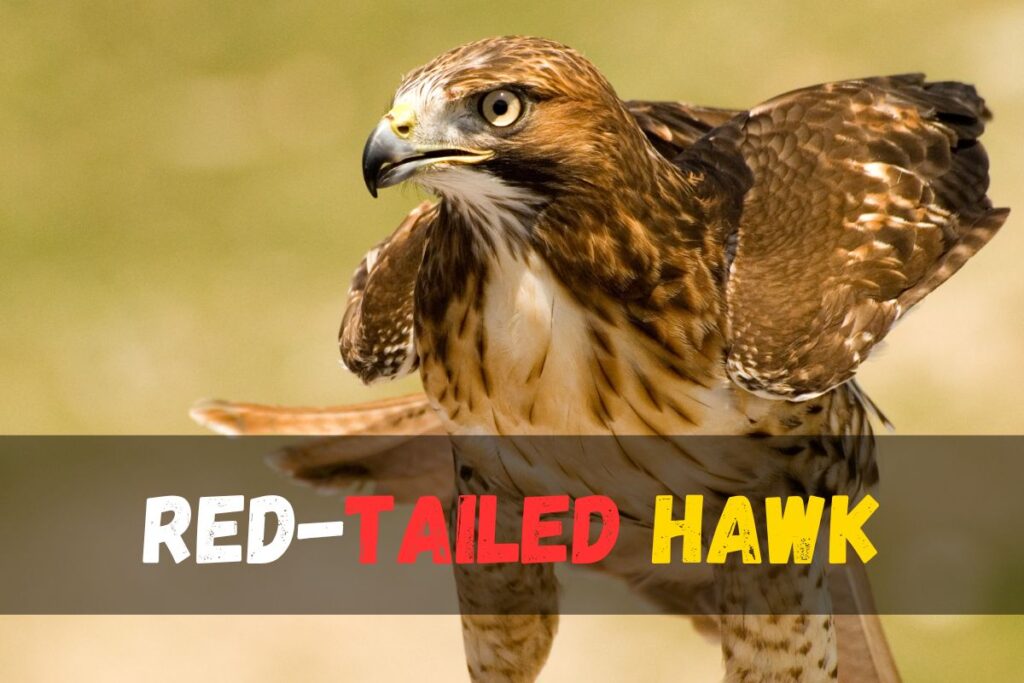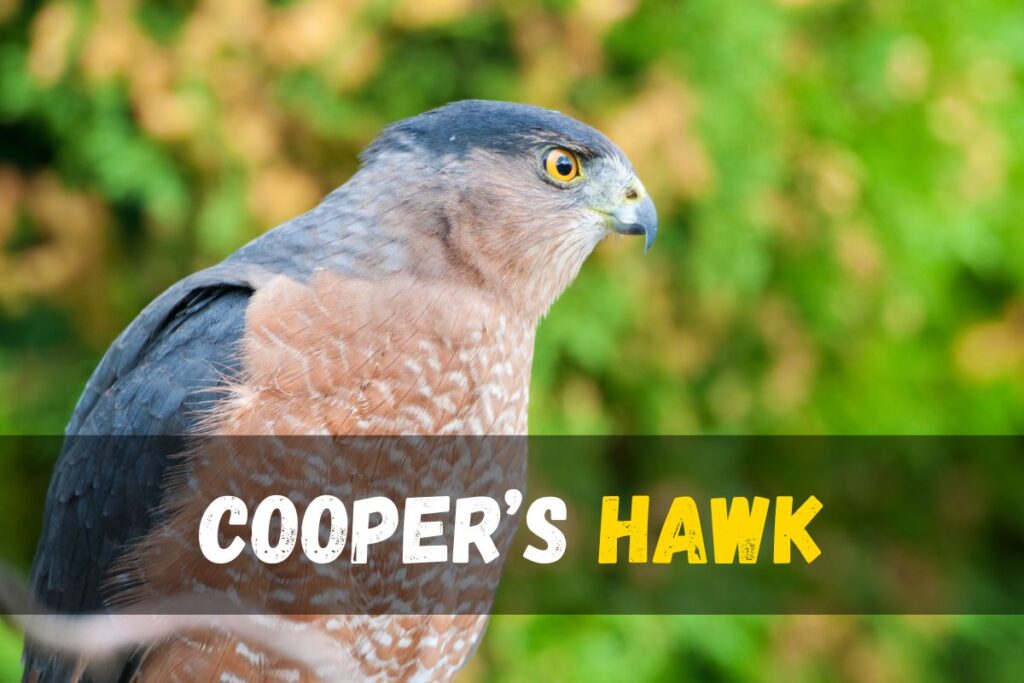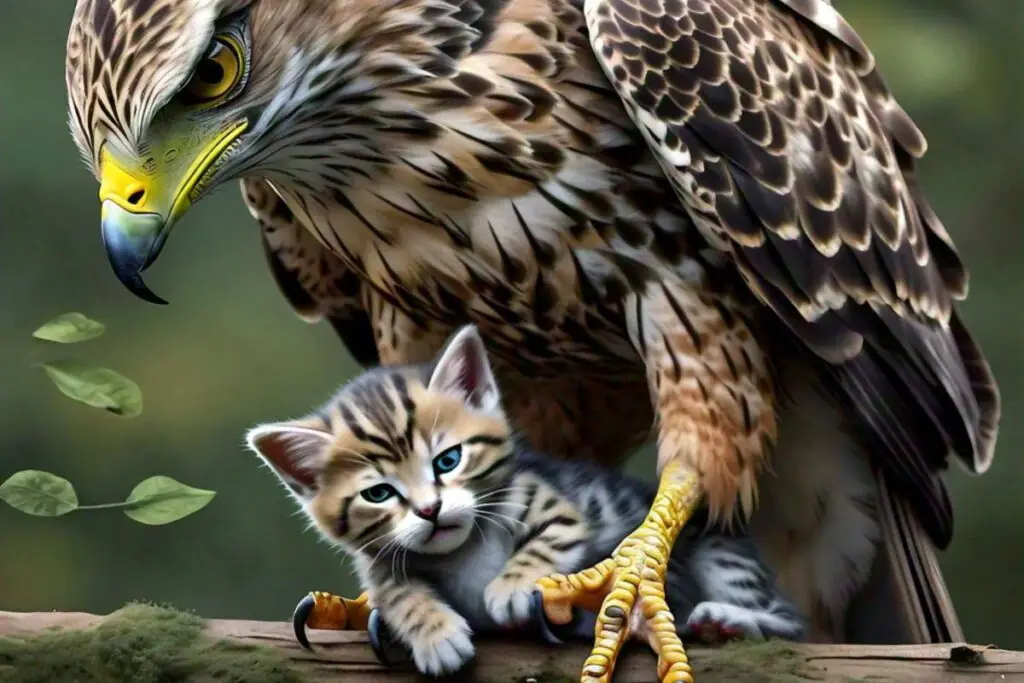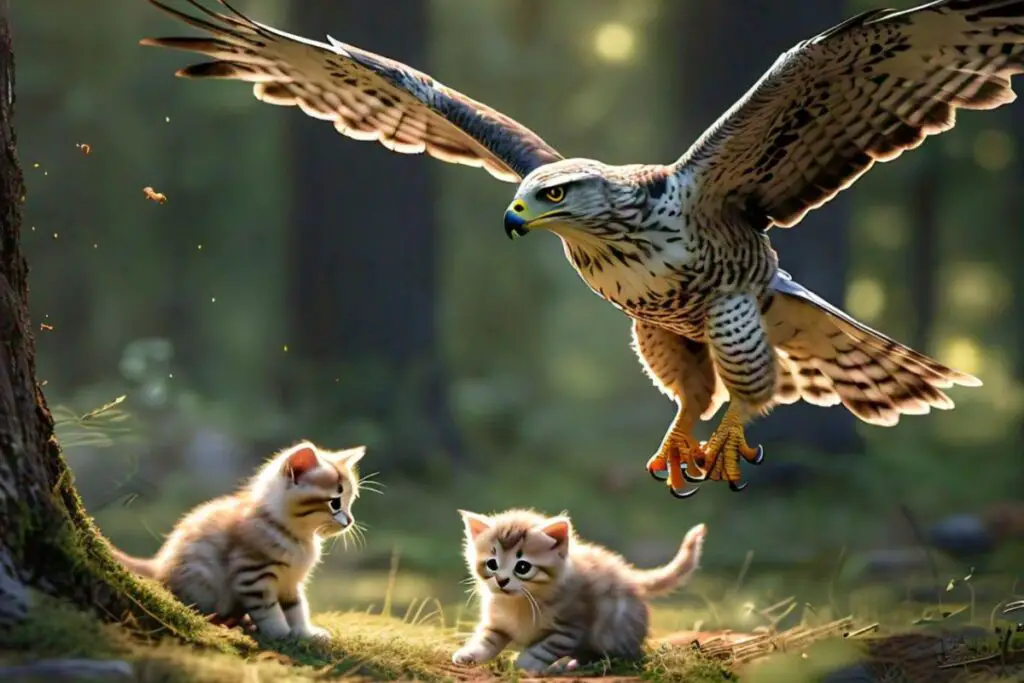Hawks generally do not make a habit of preying on cats. Their typical diet comprises smaller animals like rodents, birds, and insects. Being larger and more agile, cats are not a preferred target for most hawk species.
However, in certain situations, particularly when food is scarce, a hungry hawk might consider a cat as potential prey, especially smaller or young kittens. Red-tailed Hawks, for instance, have been known to occasionally attack young kittens, as these can be closer in size to their usual prey, like squirrels. This behavior, though, is quite rare and not typical for hawks.
Do Hawks Eat Mice?
It’s also crucial to note that even if a hawk were to attempt to hunt a cat, successfully carrying off a fully grown one would be highly unlikely due to the cat’s size and ability to defend itself. Most instances where hawks are suspected of taking cats are more likely misunderstandings or urban myths rather than common occurrences.
How Does a Hawk Kill Cats?
Understanding how hawks capture and kill cats involves looking at their hunting techniques and capabilities.
Hunting Strategy
Hawks are aerial hunters, relying on keen eyesight to spot potential prey from high vantage points such as trees or in flight. When targeting cats, hawks often look for vulnerable individuals—young, sick, or isolated from cover. Cats that venture into open areas like fields or yards become more visible and accessible to hunting hawks.

Ambush and Attack
Once a hawk spots a suitable target, it will typically initiate a swift and stealthy attack. Hawks are known for their rapid diving or swooping maneuvers, using their sharp talons to grab prey. When targeting a cat, a hawk will swoop down precisely to catch the cat off guard. The element of surprise is crucial for the hawk’s success.
Talons and Strength
A hawk’s talons are its primary weapon for capturing and restraining prey. These nails are sharp and powerful, designed to pierce through the fur and flesh of animals. Once a hawk’s talons grasp a cat, its strong grip makes it challenging for the cat to escape. Hawks have considerable leg strength, allowing them to lift and carry prey in flight.
Killing Technique
When a hawk captures a cat, it often uses its paws to inflict fatal injuries. The hawk may aim for vital areas such as the neck or head to incapacitate the cat swiftly. Hawks are adept at dispatching their prey efficiently, as they need to minimize the risk of injury to themselves during the hunt.
Precautions and Avoidance
Some precautions can be taken for cat owners concerned about hawk attacks to reduce the risk. Keeping cats indoors or supervised when outside can significantly lower the likelihood of a hawk encounter. Providing cats with outdoor enclosures or netted areas can also offer protection while allowing them outdoor access.
Do Hawks Eat Fish?
Which hawk species eat cat
A few hawks may occasionally target cats, especially smaller or juvenile individuals.
Red-tailed Hawk (Buteo jamaicensis)
The Red-tailed hawk is one of North America’s most widespread and commonly observed hawks. While its primary diet consists of rodents, rabbits, and birds, the red-tailed hawk has been known to attack small pets, including cats if given the opportunity. However, such incidents are relatively rare.

Cooper’s Hawk (Accipiter cooperii)
Cooper’s Hawks are agile woodland hunters known for preying on birds and small mammals. These hawks have been observed hunting in suburban areas and may occasionally target domestic cats, especially young or vulnerable individuals.

Sharp-shinned Hawk (Accipiter striatus)
Like Cooper’s Hawks, Sharp-shinned Hawks are adept at flying through dense vegetation and hunting small birds and mammals. While less common, they may occasionally target cats, particularly in urban or suburban settings.

Do Hawks Eat Ducks?
Health benefit for hawks eating cat
Hawks can derive certain health benefits from consuming cats, though it’s not their primary or preferred food source.
Protein Source
Cats, like many other animals, are rich in protein. Protein is essential for muscle development, repair of tissues, and overall growth. Being carnivorous birds, Hawks require a diet high in protein to sustain their energetic lifestyle. Consuming a cat provides hawks with a concentrated source of animal protein, aiding their metabolic functions and physical performance.
Nutrient Density
Cats, as carnivores, typically eat a variety of meat sources. This results in a nutrient-dense profile, rich in vitamins and minerals crucial for overall health. Hawks benefit from this nutrient density when they consume cats, gaining essential vitamins like B12 and minerals like iron and zinc, vital for maintaining optimal health and functioning.
Energy Boost
Hunting and consuming a relatively large animal like a cat provides hawks with a substantial energy boost. Cats are calorically dense compared to smaller prey items commonly eaten by hawks. The high energy content from fats and proteins in cat meat supports the bird’s high metabolic rate and sustains it through periods of intense activity.
Dietary Diversity
While hawks primarily feed on smaller mammals and birds, the occasional inclusion of a cat can contribute to dietary diversity. Diversity in diet can benefit any predator, ensuring they obtain a broad spectrum of nutrients necessary for maintaining health and reproductive success.
Can Hawks Pick Up Large Cats?
Hawks generally avoid preying on cats due to the difficulty in lifting them. Hawks are more inclined towards smaller prey and avoid larger animals, including cats, beyond a certain weight limit, typically under five pounds. However, when hawks feel threatened or have limited food options, they might attempt to lift a cat. Female hawks, slightly larger and stronger than their male counterparts, may have a marginally better chance of lifting larger cats, but this remains challenging for most hawk species.
Do Hawks Eat Bats?
How to Protect a Cat from Hawk Attacks?
You can take measures to ensure your cat’s safety without completely restricting their outdoor adventures.
Understanding the Threat
Hawks are skilled hunters that primarily target small mammals and birds. Being small and agile, cats can be seen as prey by certain species of hawks, especially if they’re left unsupervised outdoors. Understanding the potential danger is the first step toward protecting your cat.
Supervise Outdoor Time
Supervising their outdoor activities is an effective way to safeguard your cat from hawk attacks. You can quickly intervene if a hawk is spotted nearby by keeping an eye on them while they roam outside. Additionally, being present can deter hawks from swooping down on your cat.
Create Safe Outdoor Spaces
Consider creating an enclosed outdoor space or a catio where your cat can enjoy the outdoors safely. These enclosures provide a protected environment, shielding your cat from potential predators like hawks while still allowing them to experience fresh air and sunshine.
Utilize Visual Deterrents
Visual deterrents can help deter hawks from approaching your property. Hang shiny objects such as CDs or reflective tape near your home to create flashes of light that can startle hawks and discourage them from lingering in the area.
Provide Safe Shelter
Ensure your outdoor space has shelters or hiding spots where your cat can seek refuge if they sense danger. Dense shrubbery, cat trees, or covered areas can offer protection from aerial predators like hawks.
Use Predator Decoys
Placing decoys of larger predators, such as owls or larger birds of prey, in your yard can trick hawks into believing there’s a threat present, keeping them at bay. However, ensure these decoys are positioned safely and won’t harm other wildlife.
Implement Behavior Training
Training your cat to respond to commands can be beneficial in preventing hawk attacks. Teach them to come when called or to retreat to a safe area upon command, reducing the risk of encountering a hawk outdoors.
Stay Informed
Stay informed about hawk activity in your area and take necessary precautions when sightings are frequent. Monitoring local wildlife organizations or online forums can provide valuable insights into prevalent hawk behavior and potential risks to your cat.
Impact of Cat Predation on Ecosystems
Impact on Native Wildlife
One of the most profound effects of cat predation is on native wildlife populations. Cats are efficient hunters with strong instincts for stalking and capturing prey. They target various animals, including birds, small mammals, reptiles, and insects. This predation can lead to declines in local species, especially those already vulnerable or endangered.
In places like islands where native wildlife has evolved without natural predators, the introduction of cats can be catastrophic. They can swiftly decimate populations of birds that have not evolved defenses against mammalian predators.
Biodiversity and Ecological Balance
The impact of cat predation extends beyond direct mortality. When native species are hunted and reduced in numbers, it can disrupt the balance of ecosystems. Native species play crucial roles in their habitats, from controlling insect populations to dispersing seeds. A decline in these species can lead to cascading effects throughout the food chain, affecting other organisms and ultimately impacting biodiversity.
Threat to Endangered Species
Cat predation threatens endangered species struggling to survive due to habitat loss and other human-induced pressures. Cats can target rare species, pushing them closer to extinction by reducing their populations and hindering their ability to recover.
Economic Costs
Apart from ecological impacts, cat predation can have economic consequences. The loss of wildlife can affect industries such as agriculture and tourism. Additionally, controlling and managing feral cat populations can be costly for local governments and conservation organizations.
Do Hawks Eat Dead a Kitten?
Hawks generally do not eat dead animals, including dead kittens. Hawks are birds of prey and typically hunt live animals like rodents, birds, or insects. They use their sharp beaks and talons to catch and kill their prey. While they might scavenge occasionally, they are more adapted to hunting live prey. If you’re concerned about a kitten, it’s important to ensure its safety and keep it away from potential predators.

Is it possible for a hawk to lift a cat weighing 10 pounds?
It is unlikely that a hawk would be able to pick up a 10-pound adult cat. Most hawks, like red-tailed hawks commonly found in North America, have a maximum lifting capacity of around 4 pounds. While larger hawks, like eagles, can lift heavier prey, they typically target smaller animals like rabbits or squirrels rather than adult cats. However, very small cats or kittens could be at risk from certain hawks. Supervising pets, especially outdoors, is always a good idea to minimize any dangers from wildlife.
Do hawks steal kittens?
Hawks typically do not “steal” kittens by actively taking them from their owners or protected areas. However, if a kitten is left unsupervised outdoors, it could become prey for a hawk or other predators. Hawks are opportunistic hunters and will target small animals that are easily accessible, such as kittens if given the opportunity. Keeping kittens and other small pets supervised and secure when outdoors is important to protect them from hawks and other predators.

Do hawks attack humans?
Hawks generally do not pose a threat to humans and are not known to attack people unprovoked. They are typically wary of humans and will avoid confrontation if possible. However, there have been rare instances where hawks have swooped at humans, particularly during their nesting season when they are defending their territory or young. These instances are usually isolated and are not common. In general, hawks are more focused on hunting small animals like rodents, birds, and insects rather than interacting with humans.



